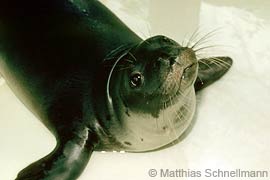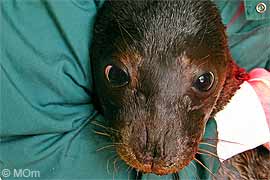
 |
||
|
|
|||||||
|
12 May 2004 |
|||||||
|
Big Day for Dimitris, the World’s Rarest SealVets, nurses and project staff prepare to bid
|
|||||||
 |
|
|
Dimitris today, looking forward to release |
Dimitris is a member of a very exclusive club: his is the rarest seal species in the world, that is also Europe’s most endangered marine mammal. When he returns home to the sea, he will join the fewer than 500 individuals of his species, the Mediterranean monk seal, or Monachus monachus, that have managed to survive.
For the past 4 months, Dimitris has been in MOm’s Intensive Care Unit on the Aegean island of Alonissos. There, under a carefully planned feeding regimen, nursing staff substituted mother’s milk for fish porridge and later, filleted fish.
During his time in rehab, he has grown from a 15-kilo foundling in critical condition to a robust 50-kilo pup.
Breezing through his last health screening, nursing staff recently pronounced him fit, free of pathogenic agents — and on course for release.
“By the time his release day comes,” says Jeny Androukaki, head of MOm’s Rescue and Rehabilitation Division, “he will exceed 50 kilos, about the weight of a well-nourished weaned pup in the wild. He has now developed good diving and hunting skills – including hunting for live fish in his pool – and he exhibits behaviour of wild monk seals, such as sleeping in the water.”
 |
|
|
Dimitris in December 2003 when he was first rescued |
Dimitris was discovered stranded on a deserted beach on the eastern Aegean island of Karpathos, following a violent December storm. The local fisherman who found the exhausted infant quickly raised the alarm – a testament, perhaps to changing attitudes in Greece, where fishermen have traditionally been hostile towards the species because of plummeting fish stocks and damaged nets.
Also known affectionately by his nickname ‘Mitsos’, Dimitris spent the following month in critical condition in MOm’s ageing rehabilitation unit on Alonissos, a portable cabin originally donated by the Seal Rehabilitation and Research Centre of Pieterburen, the Netherlands, back in 1990. Although brand new permanent facilities have been ready since 1999 at the island’s Biological Research Station, a bureaucratic snafu in Athens and a land dispute over access has continually prevented its use.
Despite blizzards, blackouts and freezing temperatures [see Monk Seal Pup on the Mend], by the beginning of February Dimitris was responding to treatment and his condition gradually stabilized. The nursing team then began preparing him for his return to the wild, modifying the feeding regimen, limiting his medical treatment to vitamins and minerals and minimizing human presence in his cabin.
On 22 May, Dimitris will at last be released into the National Marine Park of Alonissos-Northern Sporades, the only protected area for Mediterranean monk seals in Greece.
In the hours and days that follow, anxious researchers will do their best to keep track of Dimitris’ movements – not an easy task along miles of craggy coastline and open stretches of sea.
Standard flipper tags and a subcutaneous micro-transponder have their uses, but not in monitoring a seal’s movements or its re-adaptation to life in the wild.
That is why, for the very first time for a monk seal in the Mediterranean, Dimitris will also be tracked via satellite, helping researchers understand more about the post-release activity of a rehabilitated orphan. The results may also shed light on another mysterious facet of monk seal behaviour in the wild – the degree to which individual animals roam between islands and scattered seal groups.
In its tracking programme, MOm is collaborating with the Sea Mammal Research Unit of the U.K., one of the world’s most experienced institutions in marine mammal satellite tracking.
Many other organisations and individuals also contributed to Dimitris’ rescue, including the SRRC of the Netherlands, the Veterinary School of Thessaloniki and the Virology Department of Erasmus University, Rotterdam.
Providing much-needed financial assistance was the Piraeus Bank of Greece; Princess Catherine Aga Khan; the Marchig Animal Welfare Trust; members and supporters of MOm and readers of The Monachus Guardian.
Last but not least, the inhabitants of the Marine Park island of Alonissos also lent moral and practical support to the rescue, helping overcome those technical hitches that can always strike in an isolated fishing village in the depths of winter.
FOR MEDIA ENQUIRIES:
Flery Fotiadou, Public Awareness Activities Coordinator
Hellenic Society for the Study & Protection of the Monk Seal (MOm)
Solomou 18
106 82 Athens
Greece
Tel: +30 21 5222888
Fax: +30 21 5222450